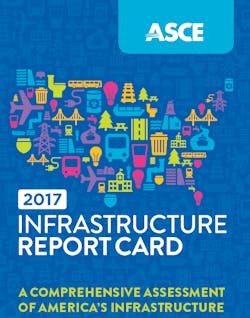ASCE 2017 Infrastructure Report Card: Energy Industry, Like USA Overall, Gets a D+
In its 2017 Infrastructure Report Card, the American Society of Civil Engineers (ASCE) has given ratings and improvement suggestions for 16 categories of infrastructure. The report, which is released every four years, began in 2001, making the 2017 Report Card the fifth edition in the series.
As in 2013, America’s cumulative GPA is once again a D+. The 2017 grades range from a B for Rail to a D- for Transit.
The electric utility industry is part of the report’s Energy category, which had a D+, as it did in 2013. Another five categories whose grades were unchanged since 2013 were Aviation, Bridges, Dams, Drinking Water, Energy, and Roads.
According to the report, “the areas of infrastructure that improved benefited from vocal leadership, thoughtful policymaking, and investments that garnered results. These improvements demonstrate what can be accomplished when solutions that move projects forward are approved and implemented.”
On page 45 of the report, the following recommendations were made for our industry (along with the Energy sector’s sub segment of the Oil & Gas industry) to improve:
- Adopt a federal energy policy that carefully assesses needed changes, including alternative energy sources such as renewables and distributed generation, to provide clear direction for meeting current and future demands.
- Streamline permitting processes, to facilitate prompt construction of critical new transmission lines and natural gas pipelines. Process streamlining must include steps to consider alternative approaches and ensure prudent and safe routing.
- Develop a national “storm hardening” plan that considers investment in T&D, refinery, and generation systems that withstand storms or that enable rapid restoration of energy supply after storm events.
- Increase new and rebuilt distribution lines’ minimum design loads for ice, wind, and temperature to improve reliability and public safety and reduce inconveniences associated with power outages.
- Promote usage of remote sensing and inspection technologies to lower the cost of energy system monitoring; focus operation and maintenance spending on highest-risk system components.
- Implement performance-based regulations that mandate verification of pipeline integrity and increased investment in early corrective action for inadequate pipelines.
- Promote usage of accepted engineering standards for all overhead T&D lines, pipelines, and support structures to help ensure safety and reliability.
About the Author
Peter Arvan Manos
Utility Industry Analyst
Peter Manos is Director of Research for Electric Power & Smart Grid, on the Energy Sector team at ARC. He analyzes the latest trends across People, Process, and Technology to uncover business and digital transformation best practices for electric, gas, and water utilities. He can be reached at [email protected]
